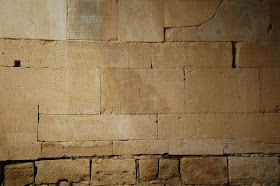This is Part 3 of what is now my four-part post about our recent trip to Greece. (Unless it turns into five parts, which is entirely possible.) If you'd like to read about Athens, see Part 1 here. If you'd like to read about Nafplio, Epidaurus, and Mycenae, see Part 2 here.
After exploring some of mainland Greece, we relocated to Crete for a week, which we spent living in a stone house in a little village called Siva. It had been the childhood home of our host, and you could see vestiges of what it had been like in an earlier time: a courtyard with an outhouse (now plumbed and containing the washing machine), a well, and a wood-fired oven. One particular treat was to be able to pick fresh oranges from the trees surrounding the house.
Siva is tiny (population 244, according to Wikipedia). It was quiet and lovely (see view above and at top), and we enjoyed staying there. It is close to Iraklion, but far enough away to have a rural feel. We enjoyed our hosts' own olive oil while we were there, especially when we learned that we had driven past the trees that produced the olives, and the press that pressed them was just down the street. It doesn't get much more local than that.
Another example of local products can be seen in this sign, just across the street from "our" house (and next door to the goat):
We didn't try this particular vintage, but we're sure it's a winner.
Siva was far too small to boast any public transportation, so we rented a little Fiat Panda from the efficient and capable Dimitris. With it, we acquired a GPS with the usual cultured female voice, courteously instructing us on where we should be going. Since we are perhaps not the very best at following instructions, we named her Cassandra, after another long-suffering woman who nobody ever listened to.
.jpg) |
| Cassandra: "Go that way!" |
Knossos
The famed palace of Knossos was our first sightseeing stop on Crete. Knossos, of course, is said to be the palace of the legendary King Minos and home to the Minotaur, complete with labyrinth, bull-leaping, Theseus, Ariadne, and all of that.
Knossos has seen more restoration, some of it questionable, than the other Minoan sites we visited, but it is still an evocative site.
Here are some of the current denizens of Knossos:
And two more well-known restored frescoes from Knossos (now in the museum in Iraklion):
Having poked around the northern edge of Crete for a while, we decided to head south. We huffed and puffed across the mountains in our little Fiat (which we think was muttering "I think I can, I think I can, I think I can..." in Greek) and found ourselves on the south coast, where it was about 10 degrees warmer.
Phaistos (Festos, Faistos)
Less restored but no less interesting than Knossos was Phaistos, for which we found a number of alternate spellings, including several on the road signs on our way to it. From around the same time period as Knossos, Phaistos is in a magnificent location, with panoramic views in all directions.
The nearby site of Aghia Triada was similar in many ways, though it was more of a village and less centered around a huge palace than either Phaistos or Knossos.
These imposing pots (and the ones from Knossos shown above) are called pithoi (singular pithos). They are seriously big. The ones from Knossos probably stand 8 or 9 feet high. We should have put a person in the picture to show the scale, but we didn't think of that until after we had left. Even today the Cretans like to decorate with them, as you can see in this picture of the house in Siva:
We did see one post-Minoan site in our meanderings. Gortyn afforded us the chance to look at Roman Crete.
It also has the Gortyn Code, or at least most of it. This law code, carved in stone in lines that reverse direction (left to right, right to left, etc.), is said to be the oldest and most complete surviving code of ancient Greek law. You'll have to look carefully to see the writing, but it is there.
Next time, we go back north and head west (with occasional help from Cassandra), to show you Rethymnon, and then east, to show you Malia.
Images in this post are either our own photos, or in the public domain.
















No comments:
Post a Comment